Related Research Articles

Alexander Joseph "Lex" Luthor is a supervillain appearing in American comic books published by DC Comics. The character was created by Jerry Siegel and Joe Shuster. Lex Luthor originally appeared in Action Comics #23. He has since endured as the archnemesis of the superhero Superman.

Do Androids Dream of Electric Sheep? is a dystopian science fiction novel by American writer Philip K. Dick, first published in 1968. The novel is set in a post-apocalyptic San Francisco, where Earth's life has been greatly damaged by a nuclear global war, leaving most animal species endangered or extinct. The main plot follows Rick Deckard, a bounty hunter who is tasked with "retiring" six escaped Nexus-6 model androids, while a secondary plot follows John Isidore, a man of sub-par IQ who aids the fugitive androids.

Perpetual motion is the motion of bodies that continues forever in an unperturbed system. A perpetual motion machine is a hypothetical machine that can do work infinitely without an external energy source. This kind of machine is impossible, as it would violate either the first or second law of thermodynamics or both.
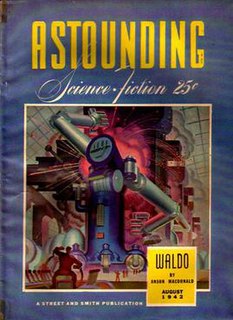
"Waldo" (1942) is a short story by American writer Robert A. Heinlein, originally published in Astounding Magazine in August 1942 under the pseudonym Anson MacDonald. It is available in the 1950 book Waldo & Magic, Inc.. Both stories in that collection involve magic but are otherwise unrelated.
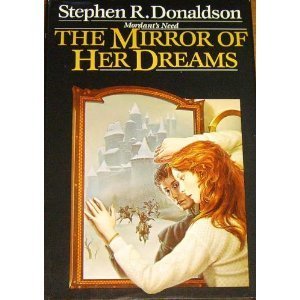
Mordant's Need is a fantasy two-part book series by American writer Stephen R. Donaldson, comprising the novels The Mirror of Her Dreams (1986) and A Man Rides Through (1987).
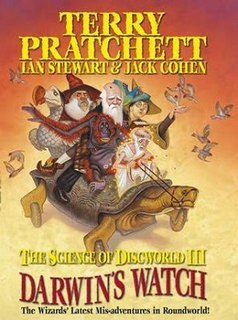
The Science of Discworld III: Darwin's Watch (2005) is a book set on the Discworld, by Terry Pratchett, Ian Stewart and Jack Cohen. It is the sequel to The Science of Discworld and The Science of Discworld II: The Globe.
The inventive step and non-obviousness reflect a general patentability requirement present in most patent laws, according to which an invention should be sufficiently inventive—i.e., non-obvious—in order to be patented. In other words, "[the] nonobviousness principle asks whether the invention is an adequate distance beyond or above the state of the art".

Connections is a science education television series created, written, and presented by science historian James Burke. The series was produced and directed by Mick Jackson of the BBC Science and Features Department and first aired in 1978 (UK) and 1979 (US). It took an interdisciplinary approach to the history of science and invention, and demonstrated how various discoveries, scientific achievements, and historical world events were built from one another successively in an interconnected way to bring about particular aspects of modern technology. The series was noted for Burke's crisp and enthusiastic presentation, historical re-enactments, and intricate working models.

GURPS Infinite Worlds is a supplement for the Fourth Edition of the GURPS role-playing game, published by Steve Jackson Games in 2005 and written by Kenneth Hite, Steve Jackson, and John M. Ford. It expands upon the campaign setting of conflict between the Infinity Patrol, which is the dimension-jumping agency on "our" Earth, referred to as Homeline, and Centrum across a multiplicity of alternate history Earths. This was presented in the Fourth Edition GURPS Basic Set.

There have been many attempts at defining science fiction. This is a list of definitions that have been offered by authors, editors, critics and fans over the years since science fiction became a genre. Definitions of related terms such as "science fantasy", "speculative fiction", and "fabulation" are included where they are intended as definitions of aspects of science fiction or because they illuminate related definitions—see e.g. Robert Scholes's definitions of "fabulation" and "structural fabulation" below. Some definitions of sub-types of science fiction are included, too; for example see David Ketterer's definition of "philosophically-oriented science fiction". In addition, some definitions are included that define, for example, a science fiction story, rather than science fiction itself, since these also illuminate an underlying definition of science fiction.

Atlas Media Corp. is a New York-based independent production company of non-fiction entertainment. The company was founded in 1989 by Bruce David Klein and produces television series and specials, theatrical documentaries, and digital web series for cable networks like Discovery Channel, Travel Channel, E! Network, TLC, Food Network, A&E, History, WE, GSN, DIY Network, Investigation Discovery, Style, National Geographic, BIO, SyFy, and HGTV—as well as national syndication and international distribution in over 100 markets worldwide.

Physics of the Impossible: A Scientific Exploration Into the World of Phasers, Force Fields, Teleportation, and Time Travel is a book by theoretical physicist Michio Kaku. Kaku uses discussion of speculative technologies to introduce topics of fundamental physics to the reader. The topic of invisibility becomes a discussion on why the speed of light is slower in water than in vacuum, that electromagnetism is similar to ripples in a pond, and Kaku discusses newly developed composite materials. The topic of Star Trek "phasers" becomes a lesson on how lasers work and how laser-based research is conducted. The cover of his book depicts a TARDIS, a device used in the British science fiction television show Doctor Who to travel in space and time, in its disguise as a police box, continuously passing through a time loop. With each discussion of science fiction technology topics he also "explains the hurdles to realizing these science fiction concepts as reality".
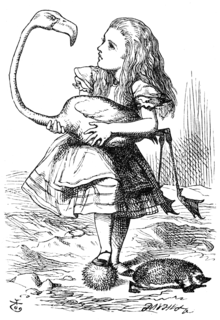
Fiction is any creative work, chiefly any narrative work, portraying individuals, events, or places in ways that are imaginary or inconsistent with history, fact, or plausibility. In a narrow sense, "fiction" refers to written narratives in prose – often referring specifically to novels, novellas, and short stories. More broadly, however, fiction encompasses imaginary narratives expressed in any medium, including not just writings but also live theatrical performances, films, television programs, radio dramas, comics, role-playing games, and video games.

A raygun is a science-fiction directed-energy weapon that releases energy, usually with destructive effect. They have various alternate names: ray gun, death ray, beam gun, blaster, laser gun, laser pistol, phaser, zap gun, etc. In most stories, when activated, a raygun emits a ray, typically visible, usually lethal if it hits a human target, often destructive if it hits mechanical objects, with properties and other effects unspecified or varying.

Ralph Osterhout is an American inventor, designer, entrepreneur, and CEO of Osterhout Design Group (ODG). During his career he has developed a range of products spanning toys, consumer electronics, dive equipment, furniture to devices for the Department of Defense. Osterhout is named as inventor on 260 patents and patent applications. Over the course of his career, Osterhout has developed over 2,000 different products and hundreds of separate product lines for companies ranging from start-ups to Fortune 500s, as well as the government.

The Invention of Lying is a 2009 American romantic comedy film written and directed by comedian Ricky Gervais and writer Matthew Robinson in their directorial debuts. The film stars Gervais as the first human with the ability to lie in a world where people can only tell the truth. The cast also includes Jennifer Garner, Jonah Hill, Louis C.K., Jeffrey Tambor, Fionnula Flanagan, Rob Lowe, Philip Seymour Hoffman and Tina Fey.

Mick Ebeling is an American inventor, entrepreneur, author, speaker and philanthropist who focuses on developing groundbreaking technology that benefits humanity. Ebeling is the recipient of the Muhammad Ali Humanitarian of the Year Award and was named as one of the “Top 50 Most Creative People” by Fortune Magazine, a WIRED Agent of Change, 2x SXSW Innovation Award winner, a 2x Tribeca Disruptor Award winner, and the only person to receive TIME Magazine’s Top Invention of the Year 2 times - for the Eyewriter in 2010 and Bento in 2021.
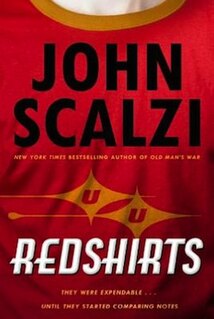
Redshirts is a space adventure by science fiction writer John Scalzi that capitalizes on tropes from Star Trek and similar television series. The book was published by Tor Books in June 2012. The audiobook of the novel is narrated by Wil Wheaton. The book won the 2013 Hugo Award for Best Novel and Locus Award for Best Science Fiction Novel.

Beyond Star Trek: Physics from Alien Invasions to the End of Time is the fourth non-fiction book by the American theoretical physicist Lawrence M. Krauss. The book was initially published on November 7, 1997 by Basic Books and since then has appeared in five foreign editions. In his previous work, The Physics of Star Trek, Lawrence Krauss explained a number of ideas and concepts featured in the series; they may or may not exist in our universe. In this book, Krauss goes farther to discuss the realities of physics when it is applied to components from other sci-fi story lines.
References
- ↑ "That's Impossible TV Listings". Tvguide.com. 2009-07-07. Retrieved 2012-08-17.